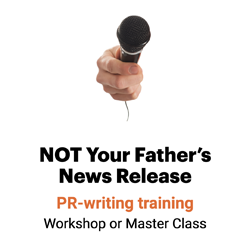Put the readers’ needs — not your products, services — up top
Which of these product release leads would you rather read? This one?

Or this one?
Me too. In the first, conventional release lead, I’m not going to make it to the second acronym. But I’ll pay attention to the company and product name in the second — a PRSA Silver Anvil Award winner — because the writer focused on reader benefits first, “us and our stuff” second.
“Present the key element … that explains how your story can benefit Forbes readers.”
— Bruce Upbin, senior editor at Forbes
So lead with the benefits and substantiate with the features. Focus on your reader’s needs first, then follow up with your organization and its products, services and ideas.
“Editors don’t care that ‘Amalgamated Technologies Has Released the New XYZ-2000 Coated Cable Bushing,'” writes Stinson Liles, principal and co-founder at Red Deluxe, “They are much more likely to be interested in ‘Phone Companies Use New Coated Cable Bushing for Difficult Underground Connections.’”
So sell the journalist on your products’ value to the journalist’s readers.
Steal a trick from these Silver Anvil winners.
These benefits leads from PRSA Silver Anvil-winning campaigns are great models of leading with the benefits and substantiating with the features.
Lead with the benefits …
Employers now have a better way to measure, monitor and manage employee absences …
Do you dread shopping for new appliances? Are you tired of being bumped in narrow aisles, searching for customer assistance and even purchasing appliances that don’t fit your needs?
On average, an employer can expect that 10 percent of its employee population will be out on a disability leave during the course of the year. To help employers better understand the types of disabilities affecting their industries and how targeted workplace solutions can mitigate associated costs and employee absences
… Substantiate with the features
… thanks to UnumProvident Corporation’s (NYSE: UNM) expanded online Comparative Reporting & Analysis (CR&A) information services.
If so, the new Northridge-area Maytag store was designed just for you.
… MetLife has made available The MetLife Series on Championing Productivity …
Make the switch.
Sometimes, a small switch is all you need to put the benefits first.
Instead of:
XYZ’s Workbench Sensor Designer tool enables engineers to quickly move from concept to simulation to prototype in a few keystrokes.
Write:
Engineers who typically take weeks to design sensor systems can now complete their designs in minutes, thanks to a new, online design tool.
Instead of:
XYZ Corporation (NYSE: XYZ) today announced that print and copy costs can be reduced up to 20 percent with our new ABC product.
Write:
Organizations can reduce their print and copy costs up to 20 percent with XYZ Corporation’s (NYSE: XYZ) new ABC product.
Instead of:
Everquest “Seeds of Destruction” is the new expansion for the Everquest video game franchise.
Write:
Gamers can level up their character to 85 in the latest expansion of Everquest’s “Seeds of Destruction.”
Next time you write a press release, brochure or newsletter article, put the reader benefits first.
“There’s nothing wrong with a story about a new product,” says Stephany Romanow-Garcia, senior process editor, Hydrocarbon Processing. “But readers want to know, ‘How am I going to use it?’ I’m not interested in ‘new and improved.”

Its all about “implications for people.” Those “people” would be the readers/viewers of the media outlets or places you want your story to appear, not the management or stockholders of the company or organization issuing the announcement. This is all typically taught in undergrad J-School. But it needs to be part of any PR and Marcom training as well.